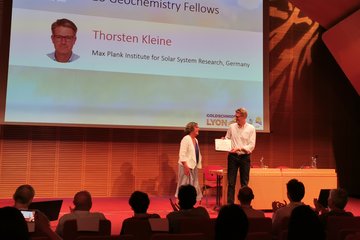Alle Typen
101.
Zeitschriftenartikel
Lunar tungsten isotopic evidence for the late veneer. Nature 520, S. 534 - 537 (2015)
102.
Zeitschriftenartikel
Pd-Ag chronometry of iron meteorites: Correction of neutron capture-effects and application to the cooling history of differentiated protoplanets. Geochimica et Cosmochimica Acta 169, S. 45 - 62 (2015)
103.
Zeitschriftenartikel
Early Differentiation and Core Formation. Washington DC American Geophysical Union Geophysical Monograph Series 212, S. 83 - 102 (2015)
104.
Zeitschriftenartikel
Hf-W chronology of the eucrite parent body. Geochimica et Cosmochimica Acta 156, S. 106 - 121 (2015)
105.
Zeitschriftenartikel
Evidence for Mo isotope fractionation in the solar nebula and during planetary differentiation. Earth and Planetary Science Letters 391, S. 201 - 211 (2014)
106.
Zeitschriftenartikel
Cosmogenic 180W variations in meteorites and re-assessment of a possible 184Os-180W decay system. Geochimica et Cosmochimica Acta 140, S. 160 - 176 (2014)
107.
Zeitschriftenartikel
Nucleosynthetic W isotope anomalies and the Hf-W chronometry of Ca-Al-rich inclusions. Earth and Planetary Science Letters 403, S. 317 - 327 (2014)
108.
Zeitschriftenartikel
Protracted core formation and rapid accretion of protoplanets. Science 344, S. 1150 - 1154 (2014)
109.
Zeitschriftenartikel
Rb-Sr chronology of volatile depletion in differentiated protoplanets: BABI, ADOR and ALL revisited. Earth and Planetary Science Letters 374, S. 204 - 214 (2013)
110.
Zeitschriftenartikel
Experimental evidence for Mo isotope fractionation between metal and silicate liquids. Earth and Planetary Science Letters 379, S. 38 - 48 (2013)
111.
Zeitschriftenartikel
Neutron capture on Pt isotopes in iron meteorites and the Hf-W chronology of core formation in planetesimals. Earth and Planetary Science Letters 361, S. 162 - 172 (2013)
112.
Zeitschriftenartikel
The abundance and isotopic composition of Cd in iron meteorites. Meteoritics and Planetary Science 48, S. 2597 - 2607 (2013)
113.
Zeitschriftenartikel
Core Formation and Mantle Differentiation on Mars. Space Science Reviews 174, S. 27 - 48 (2013)
114.
Zeitschriftenartikel
Isotopic evidence for chondritic Lu/Hf and Sm/Nd of the Moon. Earth and Planetary Science Letters 380, S. 77 - 87 (2013)
115.
Zeitschriftenartikel
Origin of isotopic heterogeneity in the solar nebula by thermal processing and mixing of nebular dust. Earth and Planetary Science Letters 357, S. 298 - 307 (2012)
116.
Zeitschriftenartikel
Nucleosynthetic Tungsten Isotope Anomalies in Acid Leachates of the Murchison Chondrite: Implications for Hafnium-Tungsten Chronometry. The Astrophysical Journal 753, S. L6 (2012)
117.
Zeitschriftenartikel
Thermal evolution and sintering of chondritic planetesimals. Astronomy and Astrophysics 537, S. A45 (2012)
118.
Zeitschriftenartikel
Thermal evolution and sintering of chondritic planetesimals. Astronomy and Astrophysics 537, S. A45 (2012)
119.
Zeitschriftenartikel
Chronology of the angrite parent body and implications for core formation in protoplanets. Geochimica et Cosmochimica Acta 84, S. 186 - 203 (2012)
120.
Zeitschriftenartikel
Hf-W chronometry of core formation in planetesimals inferred from weakly irradiated iron meteorites. Geochimica et Cosmochimica Acta 99, S. 287 - 304 (2012)











